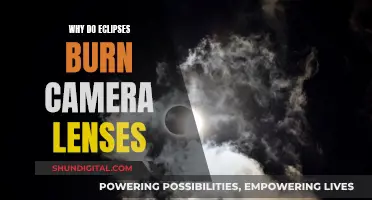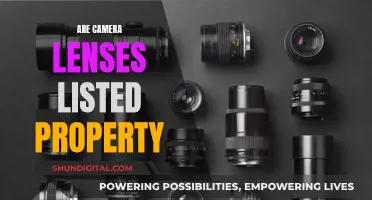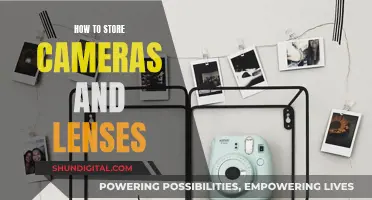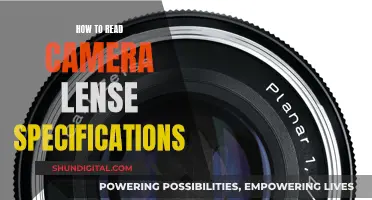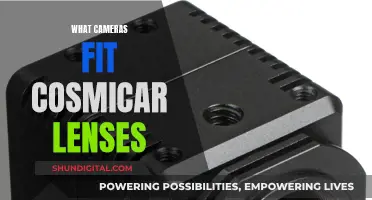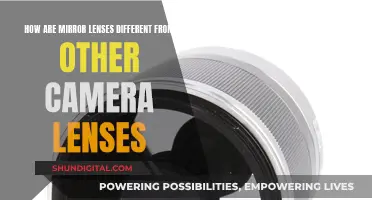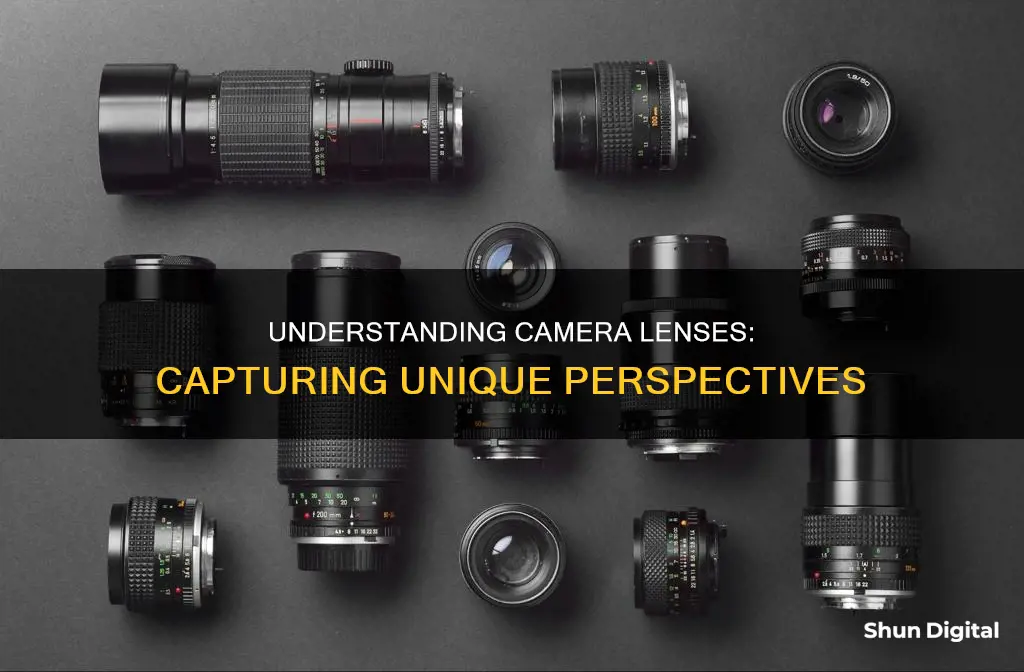
Camera lenses are essential for photographers, as they focus light from the viewfinder into a tiny spot on the camera's sensor. The lens used will determine the quality of the image, with high-quality lenses producing great photos and low-quality lenses resulting in poor ones. There are two broad categories of lenses: prime and zoom. Prime lenses have a fixed focal length, while zoom lenses have a variable focal length. The type of lens chosen will depend on the type of photo being taken, with some lenses being more suitable for certain situations than others. For example, a wide-angle lens is often used for landscape photography, while a telephoto lens is used for wildlife photography.
| Characteristics | Values |
|---|---|
| Lens type | Prime, Zoom, Wide-angle, Telephoto, Superzoom, Macro, Fisheye, Tilt-shift |
| Focal length | 6mm, 14mm, 18mm, 24mm, 35mm, 50mm, 60mm, 70mm, 100mm, 105mm, 135mm, 150mm, 180mm, 200mm, 300mm, 600mm, 1200mm |
| Use case | Landscape, architecture, street, travel, portrait, wildlife, sports, action, close-up, nature, wedding, documentary, reportage, product, abstract, city, nature/wildlife |
| Image quality | Higher with prime lenses than zoom lenses |
| Ease of use | Zoom lenses are more convenient than prime lenses as they don't require changing lenses |
| Portability | Prime lenses are smaller and lighter than zoom lenses |
| Price | Prime lenses are generally cheaper than zoom lenses |

Prime vs zoom lenses
Prime and zoom lenses are two broad categories of camera lenses. Prime lenses have a fixed focal length, while zoom lenses have a variable focal length. This means that with a prime lens, you can only capture images from a specific angle of view, whereas with a zoom lens, you can adjust the angle of view by turning the zoom ring.
Advantages of Prime Lenses
Prime lenses are often significantly cheaper than zoom lenses, and they are also generally smaller and lighter. Prime lenses offer superior image quality due to their simpler optical designs, and they can produce beautiful background highlights known as "bokeh". They are ideal for achieving very shallow depth of field and are excellent for low-light photography, as they can easily "open" up to f/2 or even f/1.2. Prime lenses also force photographers to "zoom with their feet", which can help them learn composition and find better angles.
Disadvantages of Prime Lenses
The main disadvantage of prime lenses is that they only offer one focal length. This means that if you want to adjust your framing, you need to physically move closer to or further away from your subject. Additionally, prime lenses can be more challenging to compose with and may not offer as much versatility as zoom lenses.
Advantages of Zoom Lenses
Zoom lenses offer versatility and convenience, allowing photographers to quickly adjust their composition without having to move. They are ideal for situations where space is limited or when you need to capture a variety of shots without changing lenses. Zoom lenses also tend to have image stabilization systems, which can help you achieve sharp images in low-light conditions. A single zoom lens can replace two or three prime lenses, reducing the weight of your gear and the need to constantly change lenses.
Disadvantages of Zoom Lenses
Zoom lenses tend to be more expensive, bigger, and heavier than prime lenses. They may not be as sharp as prime lenses, especially near their maximum focal length or at their widest focal length. Additionally, most budget or lightweight zoom lenses have variable apertures, which means the maximum aperture becomes narrower at longer focal lengths.
Both prime and zoom lenses have their advantages and disadvantages, and the best choice depends on your specific needs and preferences. Prime lenses are ideal for achieving shallow depth of field, low-light photography, and producing high-quality images with beautiful bokeh. On the other hand, zoom lenses offer versatility and convenience, making them suitable for situations where you need to quickly adjust your composition without moving. Ultimately, the choice between prime and zoom lenses depends on the type of photography you want to do and your personal preferences.
Student Photography: Affordable Camera Lenses for Beginners
You may want to see also

Wide-angle lenses
When shopping for a wide-angle lens, it's important to consider not just the focal length and price point but also features like autofocusing, lens coatings, and the inclusion of image stabilisation.
A Wet Camera Conundrum: Why Splash Camera Lenses?
You may want to see also

Telephoto lenses
The term "super-telephoto" is used to describe anything over 300mm (or the full-frame equivalent field of view). These lenses can be very large and expensive, and are often used by professional wildlife and bird photographers.
When choosing a telephoto lens, consider your specific needs and budget. If you're looking for a versatile lens for both wildlife and landscape photography, a super-telephoto lens may be too much. A smaller zoom range, such as a 50-400mm, might be a better option as it will be lighter, sharper, and more affordable.
The Importance of Pristine Camera Lenses for Perfect Pictures
You may want to see also

Macro lenses
While macro lenses are commonly associated with close-up photography, they are also versatile tools that can be used for other types of photography, including portraits, landscapes, and astrophotography. When used for portraits, macro lenses can produce sharp images with smooth, blurry backgrounds. For landscapes, the sharpness and flat field of a macro lens can enhance edge-to-edge sharpness. Additionally, the ability to focus on tiny details makes it a useful tool for capturing both scenic vistas and close-up images of small subjects without the need to change lenses.
One potential drawback of macro lenses in general photography is their focus throw, which refers to the amount of rotation required to adjust the focus from infinity to the minimum focus distance. Some macro lenses, especially older manual focus lenses, have a long focus throw, which can make it challenging to capture dynamic scenes. Another consideration is light-gathering ability; while some macro lenses have a maximum aperture of f/2, you won't find wider apertures in this lens category.
Overall, macro lenses offer a unique perspective and versatility, making them a valuable addition to any photographer's kit.
Exploring the Diverse World of Camera Lenses
You may want to see also

Fisheye lenses
In photography, fisheye lenses are commonly used for underwater photography, as well as landscape, architecture, and sports photography. They offer a unique perspective, with vertical and horizontal lines appearing more curved and circular. This artistic distortion can add a creative flair to images and is particularly popular for album covers and music videos, especially in the punk rock, hip-hop, and skateboarding genres.
The optics of fisheye lenses are highly specialised, often featuring multiple lens elements to capture the super-wide field of view. Some fisheye lenses are equipped with advanced coatings to minimise flare and chromatic aberration, enhancing the overall image quality.
When choosing a fisheye lens, it's important to consider the angle of view, image diameter, projection type, and sensor coverage, as these factors vary independently of focal length and aperture.
Filters for Capturing Cinematic Shots with Your Camera Lenses
You may want to see also
Frequently asked questions
A camera lens is a single or series of glass elements that sit in front of photographic film or an image sensor, helping to focus and sharpen light entering the camera body.
Camera lenses can be broken down into two types: zoom lenses and prime lenses. Zoom lenses have variable focal lengths, while prime lenses have a fixed focal length.
Zoom lenses are incredibly versatile and can be used for photographing anything from people in the streets to wildlife.
Prime lenses produce much higher-quality images than zoom lenses, but you will need to know in which situation to use them. For example, the 50mm prime lens, also known as the Nifty Fifty, is perfect for portraits.
Focal length isn't the only consideration when choosing a camera lens. You should also decide whether you want a prime lens with a single focal length or a zoom lens with some range. Look for a fast shutter speed if you'll be shooting moving objects, and a wide aperture if you'd like a shallow depth of field.


